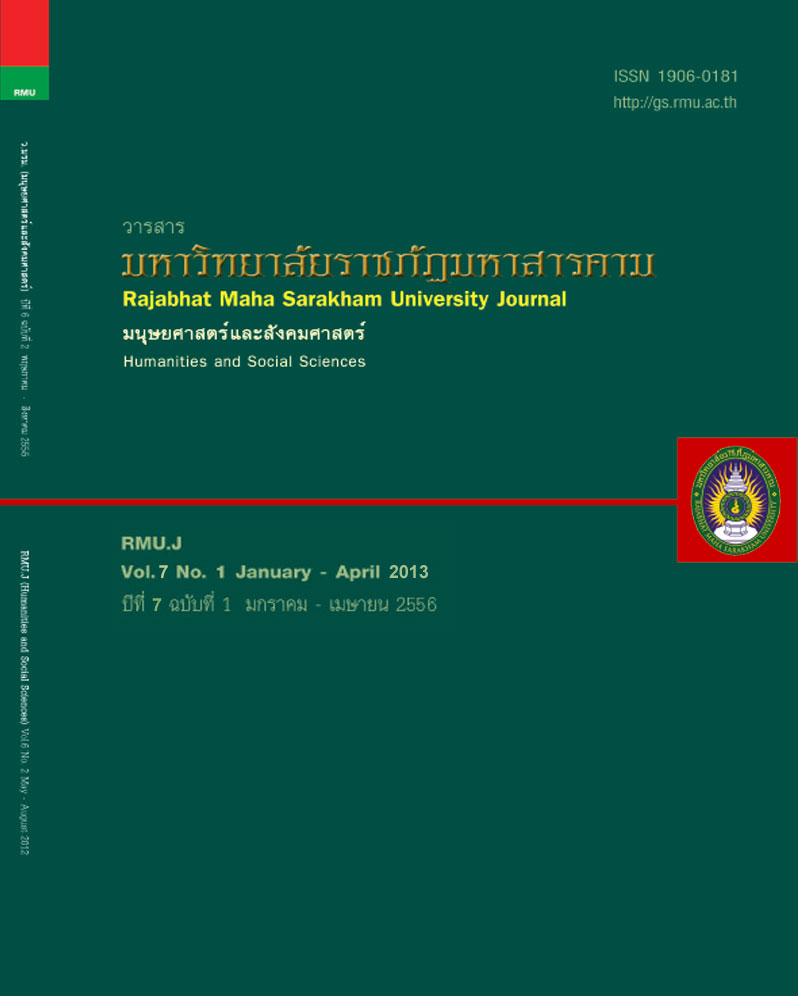การเรียนรู้ด้วยการชี้นำตนเองของผู้ที่มีความบกพร่องทางการได้ยิน
Main Article Content
บทคัดย่อ
บทคัดย่อ
การวิจัยครั้งนี้มีวัตถุประสงค์เพื่อศึกษาระดับความพร้อมในการเรียนรู้ด้วยการชี้นำตนเองและเงื่อนไขที่เอื้อต่อการเรียนรู้ด้วย การชี้นำตนเอง ของบุคคลที่มีความบกพร่องทางการได้ยิน ผู้ให้ข้อมูลคือบุคคลที่มีความบกพร่องทางการได้ยินที่ประสบความสำเร็จ จำนวน 8 คน คัดเลือกโดยใช้ 3 วิธีประกอบด้วย 1) แบบยึดจุดมุ่งหมายของการศึกษาเป็นหลัก 2) วิธีการสังคมมิติ 3) โดยคำ แนะนำของผู้เชี่ยวชาญ ใช้ระเบียบวิธีวิจัยเชิงคุณภาพ โดยการสัมภาษณ์เชิงลึกประกอบการสังเกต เครื่องมือในการวิจัยประกอบด้วย 1) แบบตรวจสอบรายการเกี่ยวกับความพร้อมในการเรียนรู้ด้วยการชี้นำตนเอง 2) แบบสัมภาษณ์เงื่อนไขที่เอื้อต่อการเรียนรู้ด้วยการ ชี้นำตนเอง 3) แบบบันทึกข้อมูลส่วนบุคคลและข้อมูลจากการสังเกต การวิเคราะห์ข้อมูลใช้ ความถี่ ร้อยละ ค่าเฉลี่ย ส่วนเบี่ยงเบน มาตรฐาน และการวิเคราะห์เนื้อหา ผลการศึกษา พบว่า
1. บุคคลที่มีความบกพร่องทางการได้ยินมีความพร้อมในการเรียนรู้ด้วยการชี้นำตนเองในระดับสูง
2. เงื่อนไขด้านตัวผู้เรียนที่เอื้อต่อการเรียนรู้ด้วยการชี้นำตนเองของผู้ให้ข้อมูลมากที่สุดคือ แรงจูงใจในการเรียน และ ประสบการณ์เดิมในการเรียน รองลงมาคือมนุษยสัมพันธ์ สุขภาพ และทุนทรัพย์ตามลำดับ เงื่อนไขด้านสิ่งแวดล้อมทางกายภาพ ที่เอื้อต่อการเรียนรู้ด้วยการชี้นำตนเองมากที่สุดคืออาคารสถานที่ต่างๆ ที่มีองค์ความรู้ตรงกับเรื่องที่ผู้เรียนสนใจ มีสิ่งอำนวยความ สะดวกในการเรียนรู้ มีความสบายใจในการเรียนรู้ หรือมีผู้เชี่ยวชาญในเรื่องที่ผู้เรียนสนใจอยู่ในสถานที่นั้น รองลงมาคืออุปกรณ์ สื่อ เทคโนโลยีสิ่งอำนวยความสะดวก ที่ผู้ให้ข้อมูลสามารถใช้ประโยชน์ได้ตามต้องการ และสภาพของชุมชนที่สอดคล้องกับหัวข้อการ เรียนรู้ของผู้ให้ข้อมูล ตามลำดับสำหรับเงื่อนไขด้านสิ่งแวดล้อมทางสังคมที่เอื้อต่อการเรียนรู้ด้วยการชี้นำตนเองมากที่สุด คือ เพื่อน เพื่อนร่วมงาน รองลงมาคือล่าม หรือผู้ช่วยจดคำบรรยาย ครอบครัว ครู อาจารย์และผู้คนในชุมชน ตามลำดับ
คำสำคัญ : การเรียนรู้ด้วยการชี้นำตนเอง, ความบกพร่องทางการได้ยิน
ABSTRACT
The purposes of this research were : Firstly, to study narcotics prevention practice of personnel in vocational institutions in the lower northeast in six aspects: educational provision; public relations; alternative activity, life skills training, peer-group activity, and environmental adjustment, secondly, to compare the narcotics prevention practice in vocational institution as perceived by personnel in vocational institutions in the lower northeast in all six aspects, and thirdly, to create the model of narcotics prevention practice in vocational institutions in the lower northeast. The subjects used for this research were 205 administrators and discipline teachers including 6 experts and also 280 personnel who were working as administrators and teachers who had worked with good narcotics prevention practice. The instruments used for collecting data were two copies of questionnaires, and one interview form. The statistics used for analyzing the data were percentage, mean, standard deviation, t-test, and F-test.
The research findings revealed the narcotics categories found in the vocational institutions ranging in the order of quantity were cigarettes, spirits, amphetamine, marijuana, glue, and thinner vapors. The narcotics prevention practice in vocational institutions was rated at the moderate level as a whole and an individual. The overall opinion of personnel with different positions and experiences towards narcotics prevention practice was significant difference. The gender and institution size were not significant difference. The model on narcotics prevention practice in vocational institutions in the lower northeast had appropriateness in six aspects difference from high to low: environmental adjustment, alternative activity, peer-group anxiety, educational provision, life skills training, and public relations.
Keywords : a model of narcotics prevention, vocational institutions, the lower northeast of Thailand
Article Details
1. บทความที่ลงตีพิมพ์ทุกเรื่องได้รับการตรวจทางวิชาการโดยผู้ประเมินอิสระ ผู้ทรงคุณวุฒิ (Peer Review) สาขาที่เกี่ยวข้อง อย่างน้อย 3 ท่าน ในรูปแบบ Double blind review
2. ข้อคิดเห็นใด ๆ ของบทความที่ลงตีพิมพ์ในวารสารมหาวิทยาลัยราชภัฏมหาสารคาม นี้เป็นของผู้เขียน คณะผู้จัดทำวารสารไม่จำเป็นต้องเห็นด้วย
3. กองบรรณาธิการวารสารมหาวิทยาลัยราชภัฏมหาสารคาม ไม่สงวนสิทธิ์การคัดลอกแต่ให้อ้างอิงแสดงที่มา

